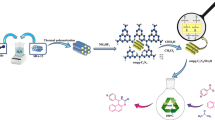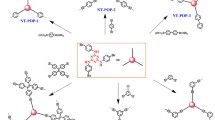Abstract
Tetra(4-dihydroxyborylphenyl)germanium as the tetrahedral units and 1,2,4,5-tetrahydroxybenzene as linkers were selected to form a crystalline porous aromatic framework, CPAF-13, with the planar five-membered BO2C2 ring in its structure by a dehydration reaction. The crystallinity of CPAF-13 was confirmed by x-ray diffraction analysis. The Ar sorption measurement on activated CPAF-13 results in a surface area of 417 m2/g, using Brunauer Emmett Teller model. CPAF-13 also shows a considerable adsorption capacity of H2.





Similar content being viewed by others
References
M.E. Davis: Ordered porous materials for emerging applications. Nature 417, 813 (2002).
M. Eddaoudi, D.B. Moler, H.L. Li, B.L. Chen, T.M. Reineke, M. O’Keeffe, and O.M. Yaghi: Modular chemistry: Secondary building units as a basis for the design of highly porous and robust metal-organic carboxylate frameworks. Acc. Chem. Res. 34, 319 (2001).
J.R. Long and O.M. Yaghi: The pervasive chemistry of metal-organic frameworks. Chem. Soc. Rev. 38, 1213 (2009).
J.S. Seo, D. Whang, H. Lee, S.I. Jun, J. Oh, Y.J. Jeon, and K. Kim: A homochiral metal-organic porous material for enantioselective separation and catalysis. Nature 404, 982 (2000).
G. Ferey, C. Mellot-Draznieks, C. Serre, and F. Millange: Crystallized frameworks with giant pores: Are there limits to the possible? Acc. Chem. Res. 38, 217 (2005).
A. Thomas: Functional materials: From hard to soft porous frameworks. Angew. Chem. In. Ed. 49, 8328 (2010).
N.B. McKeown and P.M. Budd: Exploitation of intrinsic microporosity in polymer-based materials. Macromolecules 43, 5163 (2010).
A. Thomas, P. Kuhn, J. Weber, M.M. Titirici, and M. Antonietti: Porous polymers: Enabling solutions for energy applications. Macromol. Rapid Commun. 30, 221 (2009).
A.P. Cote, A.I. Benin, N.W. Ockwig, M. O’Keeffe, A.J. Matzger, and O.M. Yaghi: Porous, crystalline, covalent organic frameworks. Science 310, 1166 (2005).
S. Wan, J. Guo, J. Kim, H. Ihee, and D.L. Jiang: A belt-shaped, blue luminescent, and semiconducting covalent organic framework. Angew. Chem. Int. Ed. 47, 8826 (2008).
H.M. El-Kaderi, J.R. Hunt, J.L. Mendoza-Cortes, A.P. Cote, R.E. Taylor, M. O’Keeffe, and O.M. Yaghi: Designed synthesis of 3D covalent organic frameworks. Science 316, 268 (2007).
F.J. Uribe-Romo, J.R. Hunt, H. Furukawa, C. Klock, M. O’Keeffe, and O.M. Yagh: A crystalline imine-linked 3-D porous covalent organic framework. J. Am. Chem. Soc. 131, 4570 (2009).
H. Furukawa and O.M. Yaghi: Storage of hydrogen, methane, and carbon dioxide in highly porous covalent organic frameworks for clean energy applications. J. Am. Chem. Soc. 131, 8875 (2009).
R.W. Tilford, S.J. Mugavero, P.J. Pellechia, and J.J. Lavigne: Tailoring microporosity in covalent organic frameworks. Adv. Mater. 20, 2741 (2008).
J.X. Jiang, F. Su, H. Niu, C.D. Wood, N.L. Campbell, Y.Z. Khimyak, and A.I. Cooper: Conjugated microporous poly(phenylene butadiynylene)s. Chem. Commun. 4, 486 (2008).
J.X. Jiang, F. Su, A. Trewin, C.D. Wood, N.L. Campbell, H. Niu, C. Dickinson, A.Y. Ganin, M.J. Rosseinsky, Y.Z. Khimyak, and A.I. Cooper: Conjugated microporous poly (aryleneethynylene) networks. Angew. Chem. Int. Ed. 46, 8574 (2007).
R. Dawson, A. Laybourn, R. Clowes, Y.Z. Khimyak, D.J. Adams, and A.I. Cooper: Functionalized conjugated microporous polymers. Macromolecules 42, 8809 (2009).
P.M. Budd, B.S. Ghanem, S. Makhseed, N.B. McKeown, K.J. Msayib, and C.E. Tattershall: Polymers of intrinsic microporosity (PIMs): Robust, solution-processable, organic nanoporous materials. Chem. Commun. 2, 230 (2004).
P.M. Budd, N.B. McKeown, and D. Fritsch: Free volume and intrinsic microporosity in polymers. J. Mater. Chem. 15, 1977 (2005).
N.B. McKeown and P.M. Budd: Polymers of intrinsic microporosity (PIMs): Organic materials for membrane separations, heterogeneous catalysis and hydrogen storage. Chem. Soc. Rev. 35, 675 (2006).
C.D. Wood, B. Tan, A. Trewin, H.J. Niu, D. Bradshaw, M.J. Rosseinsky, Y.Z. Khimyak, N.L. Campbell, R. Kirk, E. Stockel, and A.I. Cooper: Hydrogen storage in microporous hypercrosslinked organic polymer networks. Chem. Mater. 19, 2034 (2007).
P. Kuhn, M. Antonietti, and A. Thomas: Porous, covalent triazine-based frameworks prepared by ionothermal synthesis. Angew. Chem. Int. Ed. 47, 3450 (2008).
T. Ben, H. Ren, S.Q. Ma, D.P. Cao, J.H. Lan, X.F. Jing, W.C. Wang, J. Xu, F. Deng, J.M. Simmons, S.L. Qiu, and G.S. Zhu: Targeted synthesis of a porous aromatic framework with high stability and exceptionally high surface area. Angew. Chem. Int. Ed. 48, 9457 (2009).
H. Ren, T. Ben, E.S. Wang, X.F. Jing, M. Xue, B.B. Liu, Y. Cui, S.L. Qiu, and G.S. Zhu: Targeted synthesis of a 3D porous aromatic framework for selective sorption of benzene. Chem. Commun. 46, 291 (2010).
Y. Yuan, F.X. Sun, H. Ren, X.F. Jing, W. Wang, H.H. Ma, H.J. Zhao, and G.S. Zhu: Targeted synthesis of a porous aromatic framework with a high adsorption capacity for organic molecules. J. Mater. Chem. 21, 13498 (2011).
R.W. Tilford, W.R. Gemmill, H.C. zur Loye, and J.J. Lavigne: Facile synthesis of a highly crystalline, covalently linked porous boronate network. Chem. Mater. 18, 5296 (2006).
E. Stockel, X.F. Wu, A. Trewin, C.D. Wood, R. Clowes, N.L. Campbell, J.T.A. Jones, Y.Z. Khimyak, D.J. Adams, and A.I. Cooper: High surface area amorphous microporous poly(aryleneethynylene) networks using tetrahedral carbon- and silicon-centered monomers. Chem. Commun. 2, 212 (2009).
H. Lim and J.Y. Chang: Preparation of clickable microporous hydrocarbon particles based on adamantane. Macromolecules 43, 6943 (2010).
J.R. Holst, E. Stockel, D.J. Adams, and A.I. Cooper: High surface area networks from tetrahedral monomers: Metal-catalyzed coupling, thermal polymerization, and “click” chemistry. Macromolecules 43, 8531 (2010).
J. Weber and A. Thomas: Toward stable interfaces in conjugated polymers: Microporous poly(p-phenylene) and poly(phenyleneethynylene) based on a spirobifluorene building block. J. Am. Chem. Soc. 130, 6334 (2008).
E.L. Spitler and W.R. Dichtel: Lewis acid-catalysed formation of two-dimensional phthalocyanine covalent organic frameworks. Nat. Chem. 2, 672 (2010).
J.Y. Lee, C.D. Wood, D. Bradshaw, M.J. Rosseinsky, and A.I. Cooper: Hydrogen adsorption in microporous hypercrosslinked polymers. Chem. Commun. 2670 (2006).
N.B. McKeown, B. Gahnem, K.J. Msayib, P.M. Budd, C.E. Tattershall, K. Mahmood, S. Tan, D. Book, H.W. Langmi, and A. Walton: Towards polymer-based hydrogen-storage materials: Engineering ultramicroporous cavities within polymers of intrinsic microporosity. Angew. Chem. Int. Ed. 45, 1804 (2006).
T. Hasell, C.D. Wood, R. Clowes, J.T.A. Jones, Y.Z. Khimyak, D.J. Adams, and A.I. Cooper: Palladium nanoparticle incorporation in conjugated microporous polymers by supercritical fluid processing. Chem. Mater. 22, 557 (2010).
Acknowledgment
We are grateful for the financial support of the Outstanding Young Scientist Foundation of NSFC (20625102), International Science and Technology Cooperation Program (2007DFA40830), and NSFC (Grant No. 20831002).
Author information
Authors and Affiliations
Corresponding author
Supplementary Material
Supplementary Material
Supplementary materials can be viewed in this issue of the Journal of Materials Research by visiting http://journals.cambridge.org/jmr.
Rights and permissions
About this article
Cite this article
Yuan, Y., Liu, J., Ren, H. et al. Synthesis and characterization of germanium-centered three-dimensional crystalline porous aromatic framework. Journal of Materials Research 27, 1417–1420 (2012). https://doi.org/10.1557/jmr.2011.433
Received:
Accepted:
Published:
Issue Date:
DOI: https://doi.org/10.1557/jmr.2011.433




